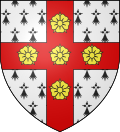Aniche
Aniche (French pronunciation: [aniʃ]; Picard: In-niche) is a commune in the Nord département in the Hauts-de-France region of northern France.
The oval medallion contains a cartouche with the name of the village over a representation of the landscape seen from the south in late summer (see the plowed field and leaves on the trees).
[10] After the creation of the first glassworks in 1823, Aniche became, from the middle of the 19th century, the French capital of the window glass industry and went from 4,000 to 7,500 inhabitants in 1900.
The Antoine Lumière & son plates and photographic papers Company (Lyon) were supplied by the Glassworks of the Station, better known under the name "Belotte Glass".
On 28 November 1900, 21 workers were killed by the explosion of 148 kg of dynamite in the Fenelon pit owned by the Aniche Mining Company.
[11] The First World War caused a sharp slowdown in industrial activity and led to the destruction by the occupying power of the majority of installations before their departure in October 1918.
Source:[13] The name of Aniche (Anic) was mentioned for the first time in 1103 in a list of the possessions of the abbey of Marchiennes, then as Enice in 1113 and Henice in 1181.






